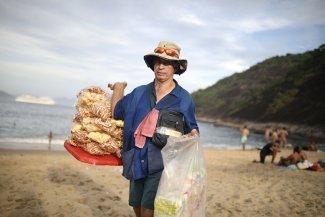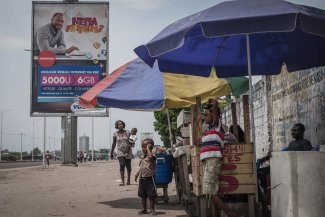Raiwan Anan-uea, 48, recalls a simple and happy adolescence in the district of Rasi Salai, where a dozen villages shared the abundant resources available in this remote corner of Isan (north-eastern) Thailand. “All year round we could grow rice, beans, cucumbers and potatoes. We could pick bamboo, catch catfish and water snails, cultivate honey, graze cattle, collect firewood and kenaf to make ropes. It was a natural pantry and a pharmacy where we just had to help ourselves. Then life became much harder.”
In the early 1990s, the Thai government initiated a series of 14 water projects on the Chi and Mun, the country’s two longest rivers, including one in Rasi Salai district. Funded by the World Bank, these structures were supposed to generate electricity, improve regulation and irrigation capacities, and create jobs. But Ubon Yoowah, a volunteer advisor at the Rasi Salai Learning Centre set up by local activists in 2010 to help those affected by the dam, says it has been a failure: “Dams are not in the public interest. The construction cost €24 million, or five times the initial budget, not including maintenance. The amount of compensation to be paid to the villagers for the loss of their land is €55 million, half of which has still not been paid. All this and the farmers still do not have enough water. The country is full of examples of poorly designed mega-infrastructure imposed without consultation.”
According to the Environmental Justice Atlas, between 15,000 and 17,000 households have been directly impacted by the Rasi Salai operation. Depending on the season, the dams along the Chi and Mun rivers exacerbate water shortages and flash floods, affecting villages, towns and cities throughout several provinces. The Rasi Salai reservoir was not built with pumping stations that would allow farmers to irrigate their fields high up during times of droughts or to drain water from fields in the lowlands during floods. Additionally, by blocking the flow of the river for eight months of the year, the reservoir has contributed to increased salinity, which has polluted drinking water sources and caused rice plants to die.
The dams were met with fierce resistance from the start. Along the 900 kilometres of the Mun River, a handful of protesters in each village secretly held nightly meetings in 1994, just after the dam opened, and made their own assessment of the losses by interviewing their neighbours. One of the most famous rural protests in Thai history took place at the Pak Mun dam (just downstream from Rasi Salai), where locals even occupied the structure. The impact of this resistance movement resonated nationally, giving birth to the Assembly of the Poor, a network of communities affected by dams, mining operations and land expropriation. “Before the age of social networks, it was the only way for them to be heard,” says Wattana Narkpradit, former secretary of the Assembly of the Poor.
“Even though the dams were built, the villagers learned not to be afraid of the officials and managed to get compensation. Pak Mun has been important in making workers, farmers, and ethnic minorities understand that they can fight for their rights in court and question the land policy.”
After years of protest, the government began a round of compensation in 1996, but only for the holders of land titles. Mae Nhoopeng, 60, lost everything: “I lost 20 rai (eight acres) of rice fields. I had no title deed, so I only received a little money for the evacuation. I lost thousands of baht with no products to sell anymore. Worst of all, I don’t have any land to give to my children and grandchildren. Even to those who could show papers, they only gave 32,000 baht (€870) per rai (a Thai unit of measure = 0.4 acres), well below its value. Relatives fought for the same plots because hardly anyone had papers. Community leaders pocketed money for themselves. It was a big mess.”
Professor Panya Khamlarp, a representative of the Association of Freshwater Fishing Communities of Isan, is part of a group of researchers coordinated by Chulalongkorn University in Bangkok, Thailand who are investigating the loss of income caused by the destruction of wetlands in Rasi Salai, the first such case in the Association of Southeast Asian Nations (ASEAN). “When they closed the floodgates in the first year and everything was under water, people were very afraid. Since then, they have been living in uncertainty. The government decides what it wants to give to the people, but it doesn’t understand what it is taking from them. Getting [further] compensation [for the destruction of wetlands] for the loss of their way of life would allow this psychological shock to be recognised.”
The director of the Royal Irrigation Department in Rasi Salai, Panari Panuphintu says he is sensitive to the desperation of the farmers: “We know that people want to stay here to make a living, so we are helping them to grow trees and to shift to crops that are better adapted to the changing environment.” But beyond these micro-projects, Panari Panuphintu remains convinced that taming nature through large buildings is the future of the region, as the government has announced its new plan to divert the course of the Mekong River as it enters Thailand: “Dams are for public use and irrigation areas are necessary. Relying only on rainwater is not enough. We have to use natural resources to provide water and all we have is the Mekong River.”
Despite warnings from environmentalists, alarmed by the loss of biodiversity and food sources in the region, hundreds of hydropower and irrigation dams have already wreaked havoc on the ecosystem of the mighty Mekong. This lifeline crossing six South-East Asian countries, on which 60 million people depend on for their daily survival, increasingly looks like a series of lifeless ponds. In the new normal, the dry season brings low levels of water, thanks to China closing the tap of the upper part of the Mekong to fill its own reservoirs. During monsoon season, heavy rainfall and water released without notice by China causes the overflow of reservoirs, sweeping away entire villages in north-east Thailand as well as in Cambodia, Vietnam and Laos. In March 2020, the Cambodian government finally reacted to the massive drop in fish volume in the Tonlé Sap lake by postponing the construction of all new dam projects on the Mekong for a decade, giving hope to communities that this window of time will allow them to convince officials to abandon dam projects in South-East Asia once and for all, and to focus on the development of sustainable energies.

The Thai government began building the 17-metre-high Rasi Salai Irrigation Dam in 1992, right in the heart of a unique wetland ecosystem, with little transparency or discussion with local villagers.
While environmental impact assessments were not mandatory in early 1990s Thailand, academics warned that the only demand for the project appeared to come from politicians and technocrats. Ubon Yoowah of the Rasi Salai Learning Centre details the infernal nexus of corruption: “To get a position in government, from the Minister of Agriculture to the sub-district chief, politicians invest large sums. To recover this money, they approve large contracts for roads or dams in exchange for bribes from various banks and construction companies, in addition to jobs or contracts for their relatives.”

Local villagers collect reeds that grow at the edge of the dam reservoir which they use to make mats. The dam has made access to 16,000 hectares of wetlands much more difficult as, these days, the area is flooded for most of the year.
“Almost nobody comes here anymore,” says Nawarat ‘Mob’ Siangsanan, a young researcher specialising in fisheries. “[The wetlands have] become a dangerous place where weeds and predators proliferate, which threaten the reproduction of other fish. Now the wetlands are submerged most of the year, so all the big trees rotted and were cut.”

Banmi Sortang, a village researcher from a community around the reservoir, stands by his home holding the books of research that he has contributed to.
Since 2000, the Thai Baan (Thai Village) programme has helped turn local fisherman and farmers into citizen scientists who collect data on the environmental damage and loss of income caused by the Rasi Salai dam.

Women community members from surrounding villages take part in the annual rice offering ceremony at the Rasi Salai Learning Centre. This ceremony, which has taken place for over two decades, uses the sale of tons of rice donated by families affected by the dam to pay for the activism and educational activities of the Centre throughout the next year.
In 2010, a group of local activists founded the Centre with funding they forced the government to provide by way of compensation. Its main goals are to educate people on how to replace their lost income by learning new means of livelihoods and fighting for the revitalisation of local ecology. The Centre also handles court cases, gathers information for researchers, organises agricultural workshops and tries to help maintain what is left of the fragile social fabric of the area.

Sombun Suphap, 65, struggles with a snake which has entered his fish trap. Since the dam has been built, the number of snakes living in the submerged trees and foliage has risen substantially. They now compete with the fishermen for natural resources.
When asked how much has been lost since the dam has been built, local chief Apirat Suthawan sighs: “The dam destroyed trees, animals, people, so many things. From a Buddhist and animist point of view, building a dam is a sin because it does not respect the cycle of nature and kills life. We just want it to be taken down and get our life back.”

With the dam reservoir came sand-mining companies, who suck large amounts of sand from the bottom of the lake to sell for construction. Many villagers oppose the environmental impact of the sand dredging and the continuous movement of large trucks on dirt track roads.
Since the early 2000s, South-East Asia’s building boom has increased demand for sand from the Mekong River and its tributaries. New research by the University of Southampton in the United Kingdom has shown that sand mining causes riverbeds to lower, leading to riverbank instability and increasing the likelihood of dangerous collapse, damage to infrastructure, and loss of housing and life.

Boongerd Khamkhun picks shellfish from the muddy bottom of the reservoir. He is part of Thai Baan, a citizen scientist research programme and in this photo, he is helping to collect information on how to best use the small part of wetland that has not been submerged. Thai Baan is also exploring ways to set up collective management so that the wetlands can be partly used in the dry season for farming or aquaculture.
Apirat Suthawan calls on the new generation to learn about the difficult history of their land: “Our young people don’t know what has happened to us because in school they learn that dams are good. I talk to them when I have the opportunity, or I broadcast information over the loudspeaker and tell them that they shouldn’t believe everything the government says. If we don’t fight for our community, who will fight for us?”












